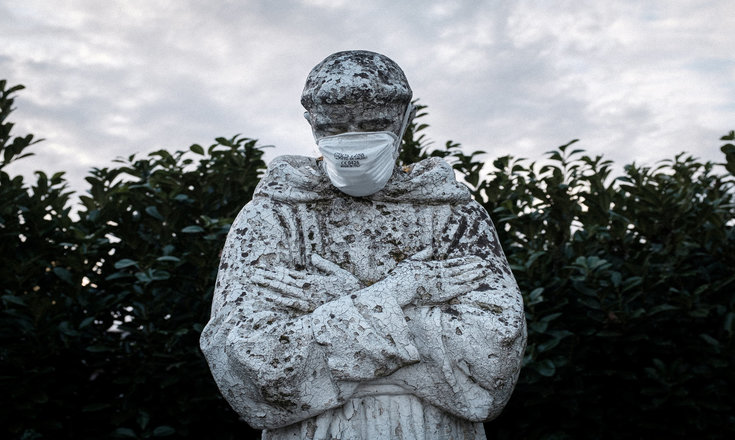In the midst of the COVID-19 crisis, we’ve seen some of the best and worst of humanity. People coming together to deliver groceries for free and offer each other supplies and kind words, neighbors shouting from balconies to stay strong and breaking out into spontaneous song and bingo games. There are also price gougers, people wiping shelves of toilet paper, scamming each other with colloidal silver and spreading purposeful misinformation. On some of the less empathetic sides of the internet (which may be an oxymoron,) there’s talk of this being Mother Nature “cleaning the earth” or that “we’re the virus,” oohing and aahing at the supposed drop in pollution as a sign that humans need to suffer a global pandemic. The pandemic will never kill off the main propagators of our problems – not so long as they have money. It will only kill off people who never did anything to deserve this. It will mostly kill the elderly, the immuno-compromised, and those with underlying health conditions.
It will mostly kill people like me.
I have several health conditions that, while not necessarily immuno-compromising by the strictest definition, can hamper the blood flow to my brain and body. Now, imagine your body doesn’t pump blood well. Imagine, then, that you stop being able to breathe correctly as well, limiting what precious oxygen you can take in. Imagine, while you’re dizzy and extremely fatigued and susceptible to so many regular infections you have to wash every inch of your body several times a day, you catch something even young healthy people describe as unbearably painful and dangerous, with sensations like “fluid filling [their] lungs” and “the air turning thin.” We haven’t even figured out the entirety of my conditions. A common cold or flu can make me so weak I can’t stand for days. Not exactly a recipe for success, is it?
But I hear this so often: don’t worry, it’ll only hurt the elderly and the already ill. I’ve heard the term “underlying conditions” so many times in the past couple days I think I might go bonkers. Don’t worry, it’s just these disposable people. These two disposable populations. When “America” tries to picture the elderly and the chronically ill, they imagine people already quarantined. They imagine lifeless lumps in rocking chairs that have no possessions, no plans, no joy or fear or desires. The elderly, the immuno-compromised, and the chronically ill are nothing more than the outline of a human, in the minds of America. In the eyes of the healthcare system, the pharmaceutical companies, the government, we are a number that talks too much. A simple statistic that likes to whine. It seems no one can imagine we might have lives or needs, that we tend to like a good outing just as much as everyone else.
Truth is, I’ve been self-quarantined and practiced social distancing before. For the better part of five years, I didn’t have a choice. I lost precious social growth and milestones to illness. I rarely, if ever, left the house. I was terrified of people. Even as I reentered society, I found the distance between my peers and I was a chasm. I find it widening with all of this, just as I thought I was beginning to close it. And this is a story many of us know: the “sick experience” is very lonely. The elderly experience is very lonely, as well. Have you ever stopped to wonder why it’s always the elderly man in line, or elderly woman on the bus, who stops to chat with you for just too long, tells you that you remind them of their grandchild? Our society tends to treat our elders with the same high regard as a single use water bottle. Oh, yeah, it served a purpose at some point. It’s important to do something with it, I think. It goes somewhere I don’t have to think about it anymore. This is our shared experience as the afterthought of America.
Seeing people panic hoarding toilet paper and wiping shelves of medical and hygiene supplies is hysterical in the most painful way possible – quite literally. I must disinfect and clean things like my headphones, phone, bedding, and more on the regular lest I get painful and irritating rashes. People need these things to keep themselves safe and clean. If they do not keep themselves clean, you will not be safe. Hand sanitizer and soap must be used by everyone to keep the infection rates down. I don’t know why this is so hard to understand. No one knows. And no one seems to know why we’re out here hoarding toilet paper, either. Please figure that one out and get back to me – and then put one back on the shelf.
Day by day, it becomes increasingly hard for the chronically ill and elderly to find their needed supplies and their optimism. Imagine yourselves for a moment in the hands of the general population. That you are the ones who need to worry. Tell me, then: how are you supposed to find happiness amid the toilet paper thievery and supply swiping? The misinformation? The panic? The shutdowns, the loneliness, the poverty, the uncertainty? Who do we get to take comfort in and isolate the misery of?
Tell me again: when you say not to worry, it’s only these groups dying – what do you really think of those groups?
Author

Danny Barber is the Managing Editor of the Seattle Collegian and an English student at Seattle Central college. She enjoys writing creatively, drawing, baking, video games, and going on long-winded random internet research sessions. After Seattle Central, she plans on getting her Master’s in English and working on the editorial board of another paper someday.







[…] I disappointed my mother’s next door neighbor yesterday, confiding to him that, although plans were made weeks prior, I would not be able to assist him in moving his king sized bedframe and mattress to my mom’s home – a generous gift as he plans to move out – simply for the seemingly obvious yet bewildering reason that I wish to be nowhere close to mom in the midst of the COVID-19 pandemic. Tim, mom’s neighbor, responded via text, “I will tell you unequivocally that I am disappointed that you have fallen in step with the panicky general population.” I retaliated, citing mom’s age (71), her COPD diagnosis and her susceptibility to illnesses in general; as I did my best to assure Tim that I myself was not afraid of becoming ill, nor were the majority of my healthy, able-bodied friends. However, in this particular case, it was not about us. […]